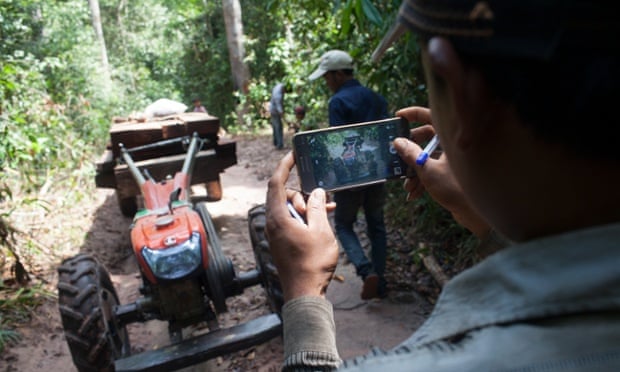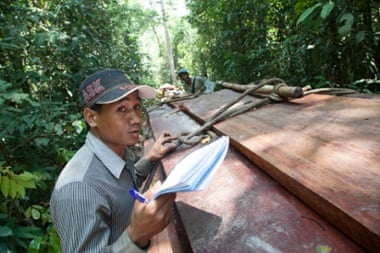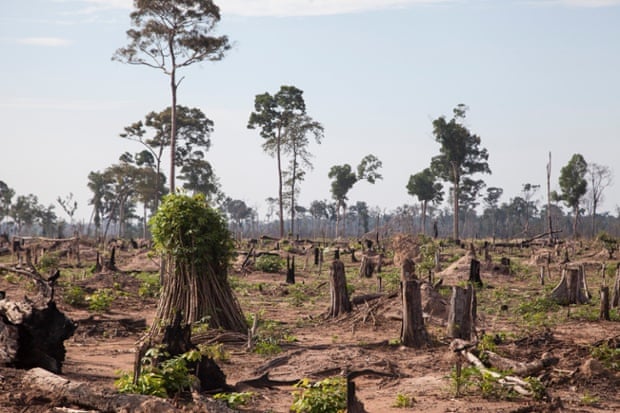Cambodia forest communities confront illegal loggers as authorities look away
Deforestation threatens one of the largest evergreen forests in
south-east Asia but local patrols are powerless to stop loggers whose
livelihoods rely on the timber
The Guardian | 13 May 2015

They stumble out on to the dirt road just in time to intercept a
shipment of timber on its way to a sawmill about 10 miles further down
the road. A man known as Hee gets off the first tractor and calmly
lights up a cigarette as Sok Plok explains that he and his companions
are members of the anti-logging Prey Lang Community Network (PLCN). He then accuses Hee of transporting illegally felled timber.
“I know,” says Hee with a shrug. “But I need to make a living. I get paid $50 for each load I transport.”
Sok Plok demands to know the name of his boss but Hee refuses to
tell him. Meanwhile, the other activists get to work, taking notes and
photographing the convoy and timber.

Prey Lang, which means “our forest” in the local Kuy language, spans
between 130,000 and 250,000 hectares and is the largest remaining
lowland evergreen forest on the Indo-Chinese peninsula, and one of the
largest in south-east Asia. It contains more than 20 species of
endangered animals and seven distinct ecosystems. Around 200,000 people
live in and around the forest.
In April, the PLCN published a report, Our Forest Remains Under Destruction, which accused political and business elites
of being directly involved in and profiting from illegal logging. The
report claimed that law enforcement and forest management officials
consistently failed to act and had no concrete prevention measures in
place.
In April, Cambodia’s prime minister, Hun Sen, told provincial governors
to take responsibility for curbing forestry crimes in their respective
provinces, and criticised officials who blame each other when illegal
logging is uncovered.
Thy Neang, an environment ministry official who manages the Cambodian Elephant Conservation Group and works in partnership with Fauna & Flora International (FFI), said Prey Lang must be preserved.
“If Prey Lang is deforested or heavily degraded, Cambodia will lose
its largest lowland forest area with high biological value, putting at
risk the existence of wildlife, including the Asian elephant, banteng
and sambar,” he said. “The loss of such an ecosystem would, in turn,
cause changes in climate, leading to droughts and water shortages in the
dry season and more floods in the wet season.
“Prey Lang is the source of the Stung Sen river, which is a major
tributary of the Tonlé Sap lake,” he said. “Loss of the forest would in
turn reduce water flow and reduce the value of ecosystem services ...
The livelihoods of people living in the area, who are dependent on the
collection of forest products including resin, wild mushrooms, wild
vegetables, rattan and medicinal plants, would also be affected.”
However, as with many disputes over natural resources, the people who
are caught in the middle – such as Hee – may have little choice but to
prioritise short-term gain.
Back in the forest, after some negotiation, the Prey Lang activists
decide to let Hee go on his way, but only after he has promised to get
out of logging. Sok Plok says he trusts Hee to keep his vow – in any
case, on this occasion the activists lack the manpower to seize the
timber. But it seems a flimsy guarantee: it is hard to see what
alternative livelihoods are available.
“I guess I could try growing cassava, I don’t know. I just want to be
able to support my family, and we are all living hand-to-mouth,” says
Hee. He is transporting a tropical forest tree – Dipterocarpus alatus –
that produces an oily resin used to varnish wood or waterproof boats.

In some villages in Prey Lang, up to 80% of households regularly
extract this resin, and for many it is the main source of income,
according to research by the University of Copenhagen. Families pass trees down through the generations.
The other big threat to Prey Lang is ever-expanding rubber plantations. In a May 2013 report,
Global Witness detailed how rubber companies “with close links to the
region’s notoriously corrupt political elites, operate with complete
impunity, devastating local livelihoods and the environment”.
Ernst Jürgensen, who heads Denmark’s Danmission
in Cambodia and helps to train PLCN activists, said the government gave
large concessions to private companies to grow rubber trees in the
forest.
“The government claims this will create employment for the people of
Prey Lang. In reality, that is seldom the case. Instead, we see how
these companies overstep their concessions and clear more forest than
they are allowed to, because there is no control or oversight,” he said.
Almost 1.6 billion people – more than 25% of the world’s population – rely on forest resources for their livelihoods. The United Nations Forum on Forests, which is meeting in New York this month,
wants to strengthen existing policies to address the effective
management, conservation and development of all forests. It aims to
forge an international policy for the next 15 years that will be aligned
with the new sustainable development agenda, to be approved in
September.
As they set up camp for their second night on patrol, the PLCN
activists, many of whom are farmers and foragers, share their concerns
about the future. Hiem Vuthy, 25, says he is worried about the
environmental consequences of deforestation.
“I’m protecting the forest to prevent the flooding and droughts that
we might get if all the trees are cut down,” he says. “I think Prey Lang
is very important for my country. It’s full of valuable resources that
many people use, so we should treasure that.”
But in the distance, the shrieks of birds blend with the unmistakable drone of a chainsaw.


No comments:
Post a Comment